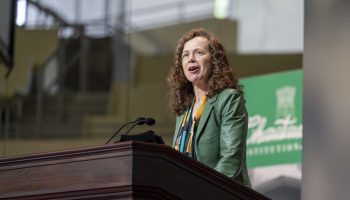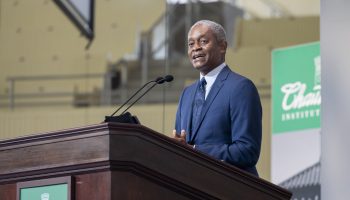NICK DANLAG – STAFF WRITER

If Warren Buffett was on a desert island and only had access to one indicator to see how well the economy is faring, he would choose freight rail. This is because, as Nancy Marshall-Genzer said, what society moves on those trains is the economy.
“I started loving trains when my kids were little. They grew out of it. I didn’t,” said Marshall-Genzer, senior reporter at American Public Media’s “Marketplace,” a nonprofit news organization that promotes economic intelligence. “Those intermodal trains are just running with the consumer goods that people are demanding, and that’s a good sign. It shows that people have money to spend, and they’re willing to spend it.”
In July 2021, freight rail was up 3% from the same month in 2020, though it has been harder to gauge how well of an indicator freight is this year. This is because many U.S. ports are backed up with ships, in part because the Suez Canal was blocked for a week earlier this year due to a ship running aground.
August, Marshall-Genzer said, will be a very important month for the U.S. economy because products for Christmas will start arriving. If they arrive late, because of labor shortages or problems at ports, stores will offset the shortages by raising prices.
At “Marketplace,” Marshall-Genzer reports “on the intersection of Washington and Wall Street, explaining how the decisions made here impact your wallet,” according to her bio on the nonprofit’s website. At 10:30 a.m. on Monday, Aug. 9 in the Amphitheater, Marshall-Genzer explored several indicators, from freight rails to consumer spending, of how well the economy is doing and why those aspects are believed to be important. This was the first lecture of Week Seven’s theme of “The State of the Economy: Where Do We Go From Here?”
The six indicators Marshall-Genzer delved into were consumer spending, freight rail, consumer confidence, inflation, unemployment rates and GDP.
The second indicator was consumer spending, which drives 70% of the U.S. economy.
In June 2021, consumer spending had grown 1%, though it dropped one-tenth of a percent in May. She said this recent increase is mainly attributed to growing comfort among consumers who are spending money for restaurants, airlines and hotels.
The COVID-19 Delta variant, she said, may cause consumers to spend less money in the coming months — though economists predict a massive uptick in spending, as much as 9%, after the pandemic because people have saved up money during COVID-19. Marshall-Genzer said this would be the largest increase in the indicator since 1946, right after World War II ended.
The third indicator was consumer confidence. In the Consumer Confidence Index by The Conference Board, economists interview 3,000 consumers a month, and ask them about their views on the economy and their own financial situations, such as how secure they, and people they know, are in their jobs; if they would consider buying a house; and their thoughts on the stock market. They found optimism has grown from June to July.
She said expectations about inflation are especially important.
“If they expect prices to increase, they go to their bosses and say, ‘I want a raise.’ Their boss gives them a raise. The boss may pass that cost onto his consumers or her consumers, and they end up paying higher prices,” Marshall-Genzer said. “That’s called the wage-price spiral.”
The fourth indicator was inflation. She said older and less-educated Americans tend to expect higher inflation.
“Now that makes sense, because many of them are living on fixed incomes,” Marshall-Genzer said. “So, they tend to track prices more closely.”
The Core Personal Consumption Expenditure Price Index (CORE PCE), was up 3.5% in July, the biggest gain since December 1991, which is over the target of 2% inflation.
As a journalist, all I can really do, with the help of these economists, is make some educated guesses, and hope consumers keep doing their job, spending, safely, even if they have to wear a mask.
—Nancy Marshall-Genzer
Senior reporter,
“Marketplace”
The fifth indicator was GDP, gross domestic product. This year during the second quarter, the GDP grew, she said, “at a screaming 6.5% annualized rate.” Marshall-Genzer said this was due to restaurants and music venues opening, and people spending money, as well as government loans to small businesses
“GDP won’t stop growing after this summer. This is partly because of the all-important holiday shopping season. Retailers are planning for and hoping for lots of retail consumer spending,” Marshall-Genzer said.
The sixth indicator was unemployment rates. In July 2021, the U.S. unemployment rate, she said, was 5.5%, which is 6 million people less than at the start of COVID-19.
“There are more than 9 million job openings across the country, and roughly one unemployed American for each of those jobs, but employers say they still can’t find enough workers,” Marshall-Genzer said. “So what’s going on?”
She attributed people not taking these openings to how long looking for a new job takes, fears about COVID-19, and unemployment benefits. Marshall-Genzer said more people are not returning to the jobs they were laid off from, and job searches can sometimes take months. She also said some people are hesitant to return to fields where they have regular close contact with strangers, especially given the spread of the Delta variant of COVID-19.
Unemployment benefits, which were raised during the pandemic, are being reeled in by the state governments to encourage people to work again, she said.
“It’s not clear yet if that’s worked,” Marshall-Genzer said. “Maybe because we don’t have all the data. We’ll know a lot more in the middle of the month when we get state-level jobs data.”
Though other factors, which Marshall-Genzer called wildcards, can prove economists’ predictions wrong. The biggest wildcard is COVID-19.
“If consumers need to stop going out to eat, cancel their trips, the economy would take it,” Marshall-Genzer said.
Marshall-Genzer ended her lecture by talking about about her own work.
“I hope this wasn’t too nerdy for you but I really do like freight trains, and I love diving into the details,” Marshall-Genzer said. “As a journalist, all I can really do, with the help of these economists, is make some educated guesses, and hope consumers keep doing their job, spending, safely, even if they have to wear a mask.”
As part of the Q-and-A session, Emily Morris, senior vice president and chief brand officer, asked Marshall-Genzer if more affluent people are more represented in consumer indexes.
Marshall-Genzer said this was the case.
“It’s really hard to get polls right,” Marshall-Genzer said. “It’s hard to reach people who are struggling.”
During one story she reported on for “Marketplace,” Marshall-Genzer looked for an American who was struggling to pay for health care. The person she found had been putting off gallbladder surgery because they couldn’t afford it.
“When she finally did get insurance, it cost $4,000, and she’s still paying off that debt,” Marshall-Genzer said. “She has slipped discs in her back. She has skin problems. She needs a root canal. She’s doing all that.”
And Marshall-Genzer was lucky to be able to interview that person.
“It is equally hard to reach low-income people, and they’re the people that we worry about the most,” Marshall-Genzer said.




